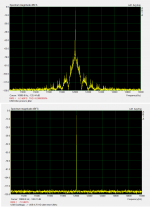why arent we using a recorded signal from a function gen? Like a pulse gen or similar rather than trying to find/capture a music transient??
-RNM
-RNM
Can't speak for "we" - but I've done that (it's in my posts). They are pretty simple to use. One you've done sine, swawooth, square and noise, you might be curious about music signals. It's the ultimate step in the verification.
Yes, video monitors are another source of interference around that frequency. Knowing the exact frequency should tell you where in the world the recording/mixing/mastering took place, as both VLF transmitters and video line/sweep frequencies differ.scott wurcer said:I've seen that in the spectra, but thought it was video monitors at 15,750.
You'd have to look very closely to tell PAL/SECAM noise from NTSC. The horizontal sweep frequencies are very close. 15.75 and 15.62 IIRC
You'd have to look very closely to tell PAL/SECAM noise from NTSC. The horizontal sweep frequencies are very close. 15.75 and 15.62 IIRC
True I observed this on the very first SONY test CD circa 1982, also undithered BTW. Highly unlikely to find those in Japan, had to love those quartz delay lines with the pencil marks for calibration.
Last edited:
Traditional PAL would be 15.625kHz IIRC. An FFT ought to be able to distinguish the various interference sources.
Maybe this is time to remind people of a possibly useful forensic idea which someone developed a few years ago: given a sound recording, you may be able to determine when it was made by looking at the frequency variation of the hum and matching this to mains frequency variations. It has some similarities to tree ring dating. I suppose someone must keep records of the mains frequency (it would be National Grid here in the UK) and can make these available to people who need to know.
Maybe this is time to remind people of a possibly useful forensic idea which someone developed a few years ago: given a sound recording, you may be able to determine when it was made by looking at the frequency variation of the hum and matching this to mains frequency variations. It has some similarities to tree ring dating. I suppose someone must keep records of the mains frequency (it would be National Grid here in the UK) and can make these available to people who need to know.
Didn't we discuss that a few years back? Or something similar? I remember something about the National Grid keeping records of frequency.
Just confirmed that I could see the different frequencies in an FFT plot using Audacity. At least with a test signal. A rectangular window worked best.An FFT ought to be able to distinguish the various interference sources.
So take the digital data and process it with any DAC you want. Claims like "we remove the jitter from the data before it is used", ARE hubris.
Hi Scott,
how about USB intrinsic jitter removal, what is your opinion.
Attachments
Hi Scott,
how about USB intrinsic jitter removal, what is your opinion.
Pavel my comment was only in the context that jitter can not impart information i.e. when I transfer a file from a USB hard drive to my computer drive for later play either the bits are the same or they are not.
There are numerous ways to clean-up jitter as long as it is not bad enough to drop data.
To repeat...
4 - Removes jitter from the music data before you play it (something not possible when playing a moving disc or a file directly)
is nonsense or stated so poorly you can't figure out what it means. It attempts to describe a process that removes jitter from data that can't be done when simply playing a file off of the disk. What does playing a file off of the disk have to do with USB? I can only conclude that they imply data transferred to a disk via USB has some unknown info-taint. That's Max's thing.
Last edited:
OK, understood. I was referring, due to inattentive reading, to the interface jitter reduction in case of S/PDIF or USB data transfer. Definitely not the case of playing a file from the hard disk.
- Status
- Not open for further replies.
- Home
- Member Areas
- The Lounge
- Ping: John Curl. CDT/CDP transports
